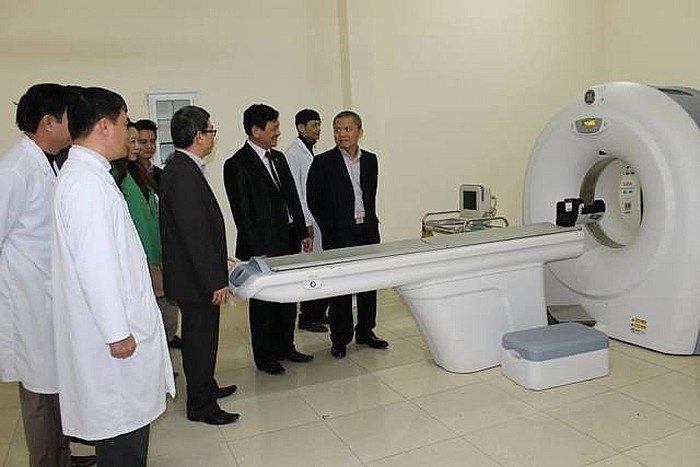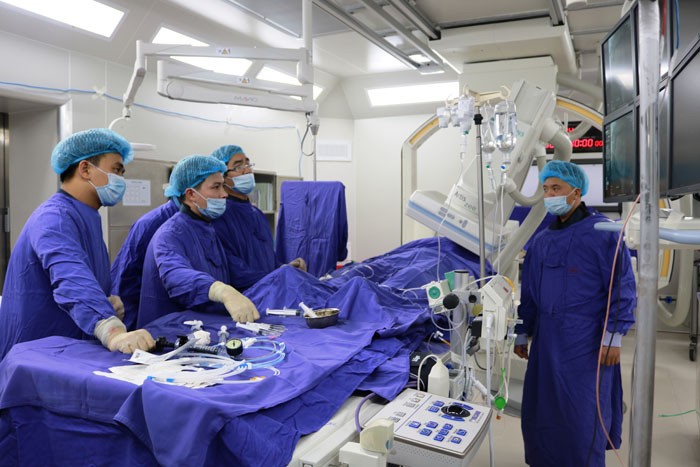(VOVWORLD) - Over the past 5 years, the Vietnamese government has invested millions of USD in a program to improve the ability of provincial and district hospitals to perform medical techniques transferred from the central hospitals. So far 23 core hospitals have transferred 2,000 medical techniques to grassroots-level health clinics. More than 85% of satellite hospitals have reduced the number of patients they send to central hospitals.
 Doctors from E Hospital in Hanoi teach cardiovascular techniques to their colleagues from Thanh Hoa General Hospital. (Photo: T.X/baomoi.com) Doctors from E Hospital in Hanoi teach cardiovascular techniques to their colleagues from Thanh Hoa General Hospital. (Photo: T.X/baomoi.com) |
After feeling a tightness in his chest from a coronary thrombosis, 71-year-old Tran Dinh Nhon of Da Lat city was hospitalized at Lam Dong General Hospital. He was lucky, because the hospital had recently set up a cardiovascular intervention unit under the satellite hospital project, which aims to lower the mortality rate of patients suffering myocardial infarctions and reduce the patient overload in central hospitals in HCMC.
Mr. Nhon said he received a stent in his coronary artery at Lam Dong General Hospital and escaped a life-threatening situation.
“I was told that the hospital’s doctors had successfully performed many similar operations. It was impossible for me to be moved to a hospital in HCMC because I was in critical condition and none of my relatives could accompany me,” Mr. Nhon added.
In the past year Lam Dong General Hospital has performed 4,000 cardiovascular operations and given first aid to more than 300 patients. Doctor Nguyen Hai Cuong, head of the cardiovascular intervention unit, said: “Since the satellite hospital program and cardiovascular intervention unit were launched, many acute myocardial infarction cases and diseases related to chest pain have been treated at our hospital. In addition to local residents, we have treated people from neighboring provinces and foreigners.”

Doctors of Quang Ninh General Hospital perform a stent placing surgery. (Photo: t5g.org.vn)
|
Quang Ninh General Hospital has been another beneficiary of the satellite hospital program. The northeastern hospital can now perform all medical techniques a top-level hospital can do plus nearly 1,500 specialized techniques that only a few hospitals at the central level can handle.
Less than 1% of the hospital’s patients have to be sent to a central hospital, according to Director Trinh Van Manh.
“The biggest problem is to ensure personnel competent to receive the medical technique transfers. Transfers must be preceded by acquisition of the necessary personnel, equipment, and infrastructure,” Manh said.
Hung Ha General Hospital in Thai Binh province, for example, lacks qualified anesthetists. That’s why it has been refused insurance coverage for hundreds of operations and has been deemed unqualified to participate in the satellite hospital program.
Luong Ngoc Khue, Director of the Health Ministry’s Medical Service Administration, said: “We need to involve not just medical facilities, but also authorities at all levels to ensure qualified personnel and sufficient investment in infrastructure to receive the transfer of medical techniques from central hospitals.”
15% of satellite hospitals have not yet reduced the number of patients they send to central hospitals for treatment, but the medical sector hopes to solve the issue of central hospital crowding by 2020.